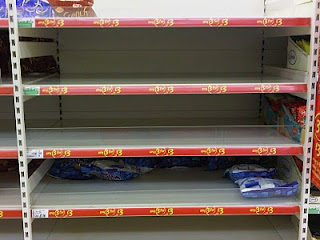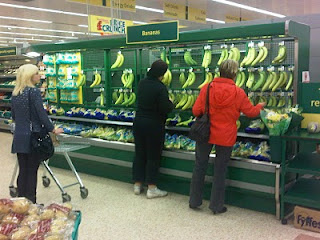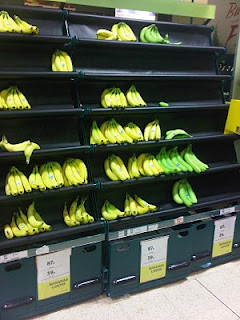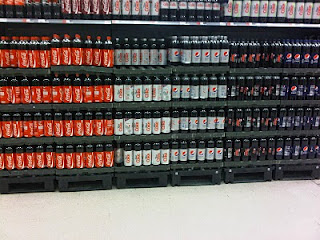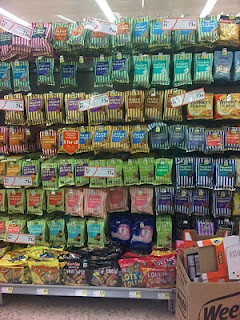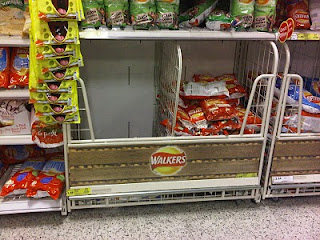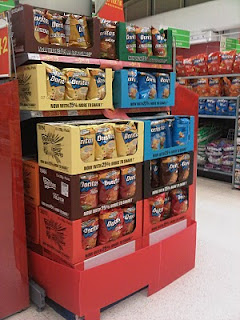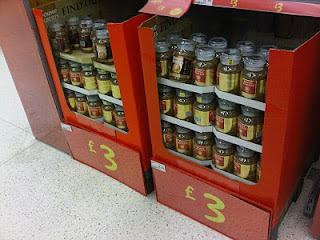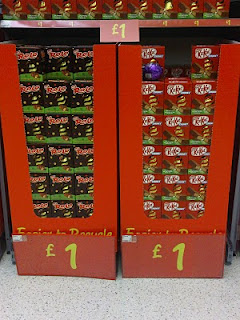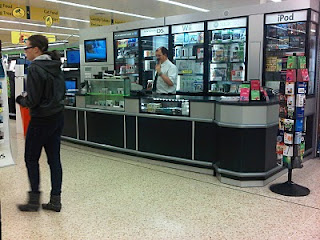Dalton Philips and Richard Pennycook alluded to the £100m efficiency savings over 3 years in the interims, their ‘self help’ that would be reinvested in the business over and above what has already been set out for the next three years or so.
The savings will come from in store efficiency savings in the main, but how will that be done? The mere mortals reading this blog may not understand how you can generate so much cost saving via just putting things on in the box they are delivered in.
Dalton spoke about efficiency at the September presentation and discussed the various ways in which store costs can be cut, then there was anything that could be introduced that saves an hour in each store equating to £1m saved to the business each week, of course that’s the key. It has to work in each store and not place unnecessary strain on other areas of the business – distribution for example.
Dalton has been trialling 28 different initiatives in the York store which cover things like opening the counters at a later time to allow greater staff coverage, using a Hand Held Terminal (HHT) for requesting signage and SEL’s from the shop floor rather than printing from the office, not facing across gaps (give impression of it being ‘full’), usage of ‘wheel in’ bread stacks and banana hammocks rather than the pre priced hanging fruit of before.
Low hanging fruit is how Dalton described the cost savings available to him at the interims and indeed I’ve touched upon the ‘scope’ that Dalton has available to deliver real quick wins and I’d be surprised if the £100m savings target isn’t extended as I feel there are real opportunities that won’t necessarily lead to a shop floor devoid of staff and a shop that hasn’t been tidied in a week.
What will be done?
Dalton is launching 5 initiatives into stores shortly (now confirmed as May) where stores will cease filling the shelves of product and instead leave gaps on the shelf where product is unavailable, I feel this is a productivity exercise as tidying empty shelves is futile but I also think that it’s a test to see how good availability actually is. I’ve heard tales of Dalton challenging why the full ‘range’ isn’t on sale so leaving gaps will highlight any issues that stores have with ordering and not allow them to paper over the cracks.
Speaking to store staff they are particularly supportive of the move, especially since it will make ordering / counting of stock far easier and reduce the loose stock that is generated by filling gaps, only to be pulled off the fixture once the missing product comes in.
Dalton also says that stock taking will be automated, the Fresh SMS counts (each section of fresh food counted over the week, bread twice for head office) are now done on the HHT rather than on paper. Grocery manual orders are done on paper and then keyed in by someone in the back office, automating these orders on a handset would be a logical step and eliminate the extra person in the chain.
Could scenes like this be commonplace in Morrisons?
Aside from the facing across and gap filling abolition, there are other initiatives that are to be rolled out across the estate that have been trialled in York.
Banana ‘cages’ are to be removed from stores and a former fundamental selling point of Morrisons (if you recall the ‘reasons’ campaign) of pre priced bananas, hung as nature intended. These labour intensive cages require a staff member to split bananas up and then add a hook, label them with a price and hang onto the cage.
The Banana Cage – May it R.I.P
The hanging grapes, pre bagged – not really sure why.
Contrast this to Sainsbury’s who just take the lid off the box (they did flirt with banana hammocks once upon a time) or Tesco who take the bananas from the box and lay them on the hammock for customers to select, the tills have scales built in as we know so the checkouts weigh them thus eliminating this laborious task (along with bagging grapes up and hanging those too).
Tesco’s banana hammock (the drawers at the bottom hold the overstock bananas).
There will be an increase in shelf ready packaging being used in stores as well, this is a two pronged assault though. With the current trend for gap filling, it means that the fixture is never reset to the planogram. Abolishing gap filling will see the planogram be ‘respected’ and this will allow the merchandisers to draw up plans to include the shelf ready packaging as well as the product to make sure it all ‘fits’ (if they haven’t done this, I’m sure they will).
Once shelf ready packaging planograms are set up it’s simply a case of removing a panel and putting the case onto the display, admittedly there are some trays that are weak and others (Mullerlight trays) that are brilliant, this is where store staff should be feeding back to Head Office on the suitability of packaging as extra time taken decanting products will mean more time taken.
It will also require indicators from head office on the plans to indicate which products are shelf ready so that colleagues are aware – preventing good shelf ready products being decanted and also ensuring that presentation is maintained and ugly holes aren’t cut in standard boxes for ‘shelf ready’ products.
The other big 3 retailers already use shelf ready packaging extensively and are moving into more novel ways to save time, especially on the bulkier lines and are leaning on suppliers to find most cost effective ways to drive efficiency.
The ordering system will continue to divide opinion with several believing it’s the best way to maintain availability, when gaps start being shown on shelves it will be interesting to see how good availability is. Certainly on Fresh I feel there’ll be gaps due to the tight stock control that is employed to save on wastage by the Sales managers.
However there are critics that it does generally delivers but it’s too variable down to the person doing the ordering and as a result warehouses fill rapidly with overstocks, with the shortest lead time in the industry (14 hours) it’s really not necessary to tie up cash flow with high overstocks due to poor ordering.
Dalton mentions that a lot of the ideas in trial are already in place in the other big 3 (Asda, Tesco, JS) and automated stock ordering is one of them, that is the practice of sales based ordering, inventories and gapscans. With the best software suite in the world coming online over the next 3 years to drive productivity throughout the business it’s difficult to see Morrisons not adopting a more Sales based replenishment system.
What else can be done / trialled / expected?
A trip to York is scheduled in for next week so with the 740 ideas from store managers, 28 initiatives and 5 roll outs it will be interesting to see what else is being trialled at the minute.
There is always scope for productivity ideas and there will be several opportunities for Morrisons specific ideas to be generated but it is worth a look around at the competition too especially since suppliers are often supplying more than one retailer.
Sainsbury’s (Asda and Tesco in particular) put their 2l fizz on the Eurostacks, these are simply wheeled on the pallet truck from the backup areas onto the shop floor for true one touch replenishment. Occasionally there are some residual overstocks that can be simply top up the stack when sales allow.
The same principle can also be used for canned goods with Tesco using this system for their own label tins and the UHT Juice and Milk. It makes filling the bulky products far easier, reduces overstocks as residual loose stocks can top up the existing bulk display rather than having cases in the warehouse.
This may be covered with the roll out of shelf ready packaging but the current system of taking each of sweets out of a case to hang it on pegs seems laborious in the extreme and considering the entire range of sweets now comes in shelf ready packaging surely it’s another candidate for removal and the addition of shelving?
Crisps are another bulky fast moving line that pose all manner of difficulties for retailers, the shelf ready solutions have come into play in the last year or so but Walkers 6pks still struggle to offer any tangible solution to retailers. Asda and Tesco have Crisp dumpbins but these don’t really solve any shelf ready problem and rather more product can be displayed to prevent selling out through the day.
Although where a tangible solution is yet to be found for 6pks, the larger sharing bags have had their shelf ready packaging relaunched early this year making replenishment for Doritos wonderfully simple. The shelves have to be adjusted to allow for the box to be placed onto the shelf, this is where the merchandisers have to be on their mettle to ensure that the benefits of shelf ready packaging are felt.
It’s these sort of fast moving products that need the solution implementing into stores, these are the ones that are generally replenished by the day shift and the ones that customers will visit – high traffic areas like Crisps, Fizzy Pop and Confectionary will benefit as it becomes easier for staff to replenish.
Asda have spearheaded their own efficiency drives within stores and it has to be said their overstock reduction programme has worked a treat with warehouse stock levels at all time lows, there is still work to do on availability though. These sorts of initiatives help staff, predominantly on offers but Coffee does benefit from the Eurostacks where branded manufacturers send in their coffee on pre filled stacks that are simply wheeled into the bay.
Asda have also put their Easter eggs on these in the past and have continued to do so this year, the cardboard outer is simply taken off the board when empty and recycled with the base returned to depot. These units make the process of keeping up with headline offers remarkably easy – the stacks that are low are cannibalised and used to top up other displays and then full stacks are brought forward from the warehouse to retain the availability. It’s remarkably simple and makes it very easy to keep on top of Easter Eggs that selling at £1 for example.
Asda uses prefilled Euro stacks successfully for Easter in particular.
Sainsbury’s have aggressively pursued shelf ready solutions to drive efficiencies since Justin King’s reign began in 2004 and they are leaning on their manufacturers for better solutions, here Walkers-Pepsico have sent French Fries / Quavers in pre filled cardboard shippers, this is a failsafe method for gondola ends where offers are popular – especially within the current climate.
Within the liberate / productivity piece, there is likely to be a review of stores techno bar that requires manning at all times due to the high value products on there. The cd’s at the minute under the present supplier are sent in unpriced and untagged – Morrisons sourced their new Canadian supplier Cinram at the expense of the MBL group. The press release for Cinram states that CD’s and media will be sent into stores pre priced and security tagged thus eliminating a lot of in store requirement (with thanks to our Northampton based correspondent.)
Could Techno bars be ‘liberated’?
There is a lot more of the low hanging fruit for Dalton to go for, I’d hope he extends his ear to the thousands of colleagues on the shop floor and within the depots as well.
Since a lot of colleagues and ‘experts’ read the blog, I’d like to throw the challenge out to them for any further cost saving ideas they’d like to be implemented.
